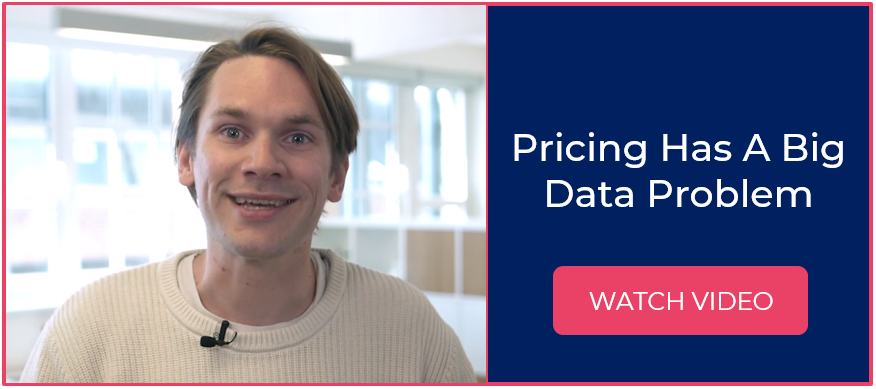Introduction
Price optimisation is the process of finding that pricing sweet spot, or maximising price against the customers willingness to pay. Companies up and down the supply chain, both in B2B and B2C settings, rightly dedicate a massive amount of time towards price optimisation to ensure that their products will sell quickly at the right price while still making a decent profit.
If an item is priced too high, it may not sell at all, while if the price is reduced too much, the business will not make a profit. Businesses use a price optimisation formula based on the overall demand for their product, their level of competition, and (in the case of manufacturers) the cost of manufacturing their goods.
Finding the perfect balance between profit and value is essentially what price optimisation is all about, and because the relative values of goods and services constantly change, this is a never-ending task for most businesses.
To assist in this vital process, software companies have developed price optimisation software packages to handle the complex calculations required. The pricing software can be tailored to meet the needs of both B2C or B2B companies.
How Price Optimisation Models Work
Price Optimisation Models are mathematical programs that calculate how demand varies at different price levels. The resulting data is then combined with information on costs and stock levels to recommend prices that will improve profits.
Price optimisation can be used to tailor pricing for customer segments by simulating how targeted customers will respond to price changes with data-driven scenarios. Given the complexity of pricing thousands of items in highly dynamic market conditions, the results help to forecast demand, develop pricing and promotion strategies, control stock levels and improve customer satisfaction.
For example, a supermarket may carry six different types of tinned tomatoes. While each of these brands may be similar in terms of overall quality, manufacturers will set their price optimisation based on their image with consumers.
A few of the tinned tomatoes on supermarket shelves may be 20 to 30% more than the generic brands, while the value brands are constantly dropping their prices in order to remain the least expensive.
For price optimisation the pricing manager will:
- Select the preferred optimisation model and determine desired goals.
- Collect historical data, including product volumes, the company's prices and promotions, competitors' prices, market conditions, product availability, seasonal conditions and fixed and variable cost details.
- Clarify the business's value proposition and set strategic rules to guide the price optimisation process.
- Load, run and revise the model.
- Establish decision-making processes that incorporate the results.
- Monitor results and upgrade data input to continuously improve pricing accuracy.
Price Optimisation Models help businesses determine initial pricing, promotional pricing and discount pricing:
Initial price optimisation works well for companies with a secure base of long life-cycle products, e.g. supermarkets, chemists, office supply stores and commodities manufacturers.
Promotional price optimisation helps set temporary prices to boost sales of items with long life-cycles - newly introduced products, products bundled together in special promotions and loss leaders.
Discount price optimisation helps businesses selling short lifecycle products subject to fashion trends and seasonality such as airlines, hotels, clothing stores.
Win-Win Outcomes
Few decisions have as large an impact on the success of your business as optimising prices. Your prices influence how many customers actually purchase your products, how your product is perceived, the types of customers you attract - and sales revenue. This all has a direct effect on your profit margins.
Every pricing decision you make should offer a win-win outcome where your customers get good value for their money and your business makes a healthy profit. So, start a review of your pricing strategy without delay – and consider investing in price optimisation software to maximise your profits.
FAQs
What are the benefits of price optimisation?
Price optimisation offers several benefits to businesses. It helps maximize profitability by finding the optimal balance between pricing and customer demand. By leveraging data and analytics, businesses can identify pricing strategies that drive increased sales, improved customer satisfaction, and overall revenue growth. Price optimisation also enables businesses to respond to market dynamics, competition, and customer preferences, enhancing their competitiveness and market positioning.
What is the formula for price optimisation?
Price optimisation involves complex algorithms and models that consider various factors. While there isn't a single formula for price optimisation, a common approach involves analysing historical data, market research, customer behavior, and pricing elasticity to determine the optimal price point. This process often includes statistical analysis, regression modeling, and demand forecasting techniques to identify pricing strategies that maximise revenue and profit.
What are the two kinds of optimisation models?
There are two main types of optimisation models used in pricing: rule-based models and machine learning models. Rule-based models rely on predefined pricing rules and guidelines set by the business, such as cost-plus pricing or competitive pricing. Machine learning models, on the other hand, leverage advanced algorithms and artificial intelligence to analyse large datasets and identify pricing patterns, demand drivers, and customer behavior. These models can adapt and learn from new data, enabling businesses to continuously optimise their pricing strategies.
Related Posts
Your Priority Should be Profitable Growth Not Higher Prices
Why Do Companies Price Discriminate
Sources
The Strategy and Tactics of Pricing, Tom Nagle and John Hogan, 2016.
Pricing with Confidence: 10 ways to stop leaving money on the table, Reed K. Holden and Mark Burton, 2014.
Pricing Strategy: Tactics and strategies for pricing with confidence, Warren D Hamilton 2014.
Pricing
Pricing and Revenue
The Art of Pricing: How to Find the Hidden Profits to Grow Your Business by Rafi Mohammed, 2005.




